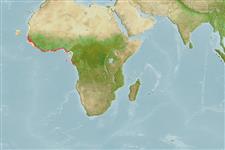Teleostei (teleosts) >
Carangaria/misc (Various families in series Carangaria) >
Polynemidae (Threadfins)
Etymology: Polydactylus: Greek, poly = a lot of + greek, daktylos = finger (Ref. 45335).
More on author: Cuvier.
Environment: milieu / climate zone / depth range / distribution range
Ecology
Marine; freshwater; brackish; demersal; depth range 15 - 55 m (Ref. 10799). Tropical; 22°N - 5°S, 26°W - 13°E (Ref. 57343)
Eastern Atlantic: Senegal to Angola (Ref. 57402). Also reported from Mauritania (Ref. 55783).
Size / Weight / Age
Maturity: Lm ? range ? - ? cm
Max length : 200 cm TL male/unsexed; (Ref. 57402); common length : 150 cm TL male/unsexed; (Ref. 3659); max. published weight: 75.0 kg (Ref. 7386)
Occurs in shallow coastal waters, over sandy and muddy bottoms, sometimes in brackish habitats (Ref. 57343, 81658). Enters estuaries (Ref. 57402), occasionally caught in fresh water (Ref. 57402, 81658). Very large specimens are only found in marine waters (Ref. 81658). Feeds on crustaceans and fishes (Ref. 10799, 81658). Flesh fairly tasteful (Ref. 57402).
Life cycle and mating behavior
Maturities | Reproduction | Spawnings | Egg(s) | Fecundities | Larvae
Motomura, H., 2004. Threadfins of the world (Family Polynemidae). An annotated and illustrated catalogue of polynemid species known to date. FAO Spec. Cat. Fish. Purp. Rome: FAO. 3:117 p. (Ref. 57343)
IUCN Red List Status (Ref. 130435)
Threat to humans
Harmless
Human uses
Fisheries: commercial; gamefish: yes
Tools
Special reports
Download XML
Internet sources
Estimates based on models
Preferred temperature (Ref.
123201): 22.3 - 28, mean 26 °C (based on 48 cells).
Phylogenetic diversity index (Ref.
82804): PD
50 = 0.5000 [Uniqueness, from 0.5 = low to 2.0 = high].
Bayesian length-weight: a=0.00661 (0.00510 - 0.00855), b=3.09 (3.03 - 3.15), in cm total length, based on LWR estimates for this species (Ref.
93245).
Trophic level (Ref.
69278): 4.0 ±0.66 se; based on food items.
Generation time: 2.7 ( na - na) years. Estimated as median ln(3)/K based on 2
growth studies.
Resilience (Ref.
120179): Medium, minimum population doubling time 1.4 - 4.4 years (K=0.34-0.41; assuming tm=3-4).
Prior r = 0.57, 95% CL = 0.37 - 0.85, Based on 3 data-limited stock assessments.
Fishing Vulnerability (Ref.
59153): Moderate vulnerability (44 of 100).
Climate Vulnerability (Ref.
125649): Very high vulnerability (87 of 100).
Nutrients (Ref.
124155): Calcium = 59.4 [32.4, 109.8] mg/100g; Iron = 0.818 [0.418, 1.451] mg/100g; Protein = 20.1 [18.5, 21.7] %; Omega3 = 0.213 [0.132, 0.349] g/100g; Selenium = 79.1 [38.5, 162.9] μg/100g; VitaminA = 6.04 [2.46, 14.30] μg/100g; Zinc = 0.742 [0.514, 1.115] mg/100g (wet weight);
